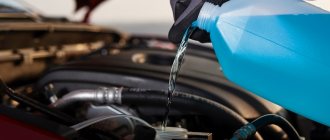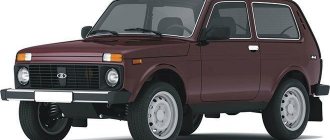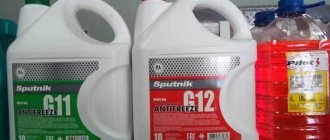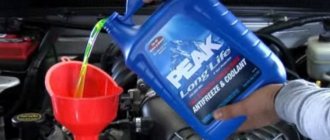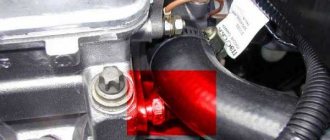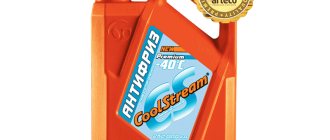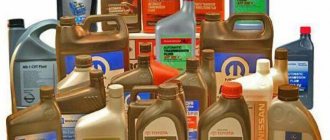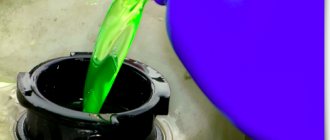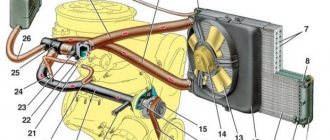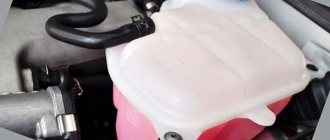It's time to replace the coolant in the engine with a new one; the car has been running on it for more than 5 years. Although, according to the standard, it should be changed every 2 years or 60 thousand km.
Thus, long-term operation of a car on old fluid is fraught with rapid wear of the pump, corrosion of internal engine parts, souring of the heater tap, leaking pipes, deterioration of heat transfer, etc.
Initially, blue antifreeze class G11 was poured into the car and over time the liquid changed color from blue to blue-green, became cloudy, and a coating formed at the bottom of the expansion tank.
Therefore, this time we will fill in antifreeze of a more advanced class G12+, red in color, with a specified service life of up to 5 years.
Let's pre-flush the system with a special flush.
First, you need to drain the old fluid from the radiator and engine block; they have a faucet and a drain plug, respectively.
We use a suitable hose for convenience - the liquid is toxic. In our case, a pre-heater is installed on the engine instead of a plug, so we’ll simply remove one of its pipes.
We open the caps of the radiator, tank and heater tap for better release of liquid. About 8 liters of antifreeze should drain (cooling system capacity 8.6 liters).
Now we will flush the system with water from a hose under pressure, after closing the radiator tap until clear liquid begins to come out of the block.
Then we close the drain holes, fill in the flush and fill the system with water.
To better remove air, remove one of the throttle heating pipes until liquid flows out, and put it back on.
We start the engine and, according to the instructions, let it run for 10-15 minutes, at the same time adding water and pressing the upper pipe until the air stops escaping.
This time is just enough to warm up the engine to 100 °C by the time the cooling fan turns on.
At the same time, turn on the interior heater fan at full power and open the tap to clean the radiator.
After warming up, turn off the engine, let it cool a little and drain the flushing fluid.
No large flakes or inclusions were found.
We rinse the engine again with running water and let it drain thoroughly. While it is draining, you can replace worn out and stiffened pipes (it is better to replace them as a set).
In our case, this is a pair of pipes going to the thermostat; one cracked; the other, due to loss of elasticity, was leaking liquid that dripped onto the generator.
Now you can start filling in new antifreeze; first close all drain holes.
Approximately 8.6 liters of antifreeze should enter the system. To better fill the system, we again remove the throttle heating hose, start the engine and, as air leaves the radiator, top it up, pushing through the upper pipe.
When the air stops escaping, fill the liquid up the neck and close the radiator cap. Fill the expansion tank above the min mark.
Warm up the engine to operating temperature, keeping an eye on the pipes. Don’t forget to turn on the stove; warm air should blow from it, then hot air as it warms up.
When the fan operates, turn off the engine, check the pipes for leaks, and tighten them if necessary. In this case, the level in the tank should rise slightly and drop as it cools.
Also, over the next few days, we check whether there is any liquid dripping anywhere, since when washing, the old protective layer from additives is removed, and a new one has not yet formed.
A short video:
When do you need to change antifreeze in a VAZ 2107 car and how much will it be needed?
The standard antifreeze, which most VAZ 2107 car owners use, has a short service life - 2 years or 60,000 kilometers. When using other coolants, these figures may vary, so you must follow the recommendations of the manufacturers of such materials.
Answering the question of how much antifreeze is in the VAZ 2107, it should be said that the mentioned figure will be the same for the entire model range of classic Zhiguli cars - 9.85 liters.
The following fluids can be used for replacement:
- In models produced before 1998, you can use regular antifreeze or G11 class antifreeze
- In the "sevens" produced from 1998 to 2002, you can use regular antifreeze or G12 class antifreeze
- For “sevens” produced from 2003 to 2012, it is best to use G12+ or G12++ class coolants
Why does it flow
There are many options for why coolant may leak. It is very difficult to determine this location of the leak. The main ones are:
- View all pipes; perhaps one of the clamps is not clamped properly.
- The pipe itself has cracked from time to time.
- The cause of mechanical damage is in the radiator. This can be corrected by welding or gluing. You can determine the location of the leak in the radiator using dismantling or gel sealant.
- Water pump. Over time, the pump, like any other part, can wear out and leak. In this case, the pump will have to be replaced.
- The element leaks out from under the head. It is better to correct such a leak at a service center, since this will require disassembling the engine.
- When the element leaks directly into the vehicle's cabin. This can be determined by lifting the floor mat on the driver or passenger side.
Signs of aging antifreeze
Antifreeze, like any other working fluid in a car, has its own resource. To determine that antifreeze needs to be replaced, you need to understand what signs indicate this.
Firstly, you should pay attention to the temperature conditions of the engine. If the power unit is constantly overheating, the cooling fan is constantly running, the coolant temperature needle is in the red zone, and steam is coming from the radiator - you must first check the condition of the cooling system and the antifreeze itself. In the case of the “seven”, such problems usually arise in the warm season, and in worst cases, in winter.
Secondly, the produced antifreeze has an unpleasant odor. You can smell it from the radiator or expansion tank. It should be understood that if the coolant begins to smell, then all permissible periods for its replacement have already passed. It is possible that in this case it may be necessary to repair some elements of the cooling system.
The third thing you need to look at is the color and consistency of the antifreeze. Slight darkening of the coolant is not a sign of a necessary replacement, but a strong change in color and thick consistency of the antifreeze indicates that a large amount of contaminants has accumulated in it.
If one or more of the described symptoms is present, the coolant must be replaced immediately, regardless of whether it is fresh or not.
Possibilities for upgrading the machine
In the nineties of the last century, many owners of VAZ 2107 cars, not particularly counting on gas stations, installed an additional tank in the car. This is much more convenient than pouring fuel from cans. Typically, such a container was located behind the rear seat in the trunk. It could have different sizes, and accordingly they had the appropriate capacity.
The driver in those days often encountered empty gas stations, and the additional volume of the fuel tank greatly expanded the capabilities of the car. Knowing the required amount of technical fluids is necessary for routine maintenance of the engine and other systems.
What is needed to replace antifreeze?
First you need to prepare the place where the work will be carried out. It is best to drive the car onto an overpass, hole or other flat surface. It is allowed that the front part stands higher than the back; any other options are unacceptable.
Now let's move on to what is needed for replacement:
- A set of keys
- Flat and shaped screwdrivers
- Container for collecting waste coolant
- Engine drain hose
- Fresh antifreeze
- Funnel for filling
- Special product for removing dirt from bolts and plugs or gasoline
Now let's look at the basic safety requirements that must be followed when replacing the coolant.
All work should be performed with the engine cool. The operating temperature of the coolant is within +90 °C, so it is strictly forbidden to open the radiator and check the condition of the antifreeze. Otherwise you may get severe burns.
Replacement is best done in a ventilated area or outdoors. Antifreeze is poison, and its vapors are no less dangerous than the liquid itself. Therefore, you also need to ensure that it does not enter the body.
Repair with improvised means
If you are away from a garage or home where you have the necessary tools to remove the tank, you can carry out emergency repair work. For this you will need to have on hand; “Moment” glue or any other composition for rubber or plastic; a piece of tire, thin rubber or plastic bottle.
Look for a leak on the fuel tank; most often it is located at the bottom, since the tank is corroded by moisture or holes. Glue the patch to this place, hold it for a few minutes and leave for 2-3 hours until the composition has completely set. After such repairs, you will easily get to the nearest service station. There have been cases where motorists used a tank patched on the road for up to several weeks, but you should hurry up with major repairs, as sometimes patches do not help.
For the second emergency repair option, you will need to have a self-tapping screw on hand. If the diameter of the hole in the tank is small, then it is advisable to screw a simple self-tapping screw into it with a rubber or neoprene washer put on it. You can make your own washer from a piece of rubber bladder. In this case, screw the screw directly through the small rubber flap.
Remember that any of the described repair methods is a temporary measure. Stop at the nearest car service center so as not to encounter a more global problem while traveling or away from populated areas if you often go on intercity trips.
Replacing antifreeze in a VAZ 2107
Let's move on to replacing antifreeze in a VAZ 2107. Conventionally, the procedure can be divided into 3 stages: draining the old antifreeze, flushing the cooling system and adding fresh fluid.
Draining old antifreeze
The first step is to remove the engine crankcase protection, if there is one. On Zhiguli cars it is most often in a deplorable state, so it is better to use special means that will free soured bolts, for example, WD-40 or EFELE UNI-M Spray.
Remember that on older cars the bolts rust over time and become very brittle, so you need to be careful when removing them.
Next, you need to move the heater control lever to maximum from inside the car. There is no need to start the heater itself. After this, open the filler neck of the radiator and expansion tank. This will allow you to drain the old antifreeze faster.
Depending on the radiator model, there may be two options for draining the liquid. If an original radiator from the latest models is installed, you need to find a special faucet on it to drain the coolant. As a rule, it turns sour during operation, so it must be pre-treated with the agents mentioned above, and then carefully opened and drained of the antifreeze.
On cars that are equipped with a radiator from older models, you can unscrew the fan switch off sensor, which is located on the inside of the radiator on the right side, if you are facing the car, or remove the hose from the lower radiator pipe.
After draining the antifreeze from the radiator, you need to remove the coolant from the internal circuit of the cooling system. We find a drain plug on the cylinder block - it looks like an ordinary 13 bolt. We unscrew it and drain the antifreeze through a pre-prepared hose.
Next, you should drain the antifreeze from the expansion tank. Unfasten the belt securing the container and lift it 30-40 centimeters up. This will allow the remaining antifreeze to enter the radiator, and from there into the collection container.
Flushing the cooling system
Flushing the engine cooling system is not a mandatory procedure. But there are situations when it is necessary. For example, when switching to another antifreeze. This is due to the fact that different brands of coolants have different chemical compositions. Therefore, in this case it is better not to neglect it.
Flushing is also necessary if there are plugs or serious contaminants in the cooling system that negatively affect engine operation.
It would be a good idea to flush the cooling system in a recently purchased car. Many owners of domestic cars most often use cheap antifreeze, after which it is best to perform this procedure.
If you flush the system, do not forget about the expansion tank. All hoses need to be disconnected from it and removed from the mounts, and then thoroughly rinsed from the inside.
Read more about how and what to flush the engine cooling system in our article on this topic.
Adding fresh antifreeze
We move on to the last stage - pouring fresh antifreeze into the cooling system. First you need to disconnect the hose from the intake manifold fitting located under the carburetor. If you have an injection engine, then the receiver heating hose is disconnected. This is necessary in order to avoid the formation of air locks in the system. These hoses are held on by clamps, so you will need a screwdriver to work.
Next, pour new coolant into the expansion tank to a level that exceeds the minimum by 3-4 centimeters. Once this is done, antifreeze will begin to flow out of the previously vacated hole on the intake manifold or receiver. After this, the hose is put back on and tightened with a clamp.
After filling, screw on the cap of the expansion tank, warm up the engine and let it run for 10-15 minutes. Then turn off the engine and let it cool. Checking the coolant level. If necessary, add antifreeze to the maximum level mark, which is marked on the tank.
Over the next few days, you should operate the car carefully and check the antifreeze level in the system. If the engine does not overheat and the coolant level does not drop, the replacement was successful.
Remember that monitoring the condition of the cooling system and using high-quality antifreeze will significantly increase the reliability of the VAZ 2107 engine.
Lack of fluid and consequences
The disadvantage of antifreeze is rapid evaporation; you also have to solve the problem of leakage. It happens that liquid can be seen leaking under the car. There are also cases when it goes into the car interior, this indicates a breakdown of the heater taps, they need to be replaced.
In addition, smoke may be emitted from the exhaust pipe. This occurs due to a faulty cylinder head gasket. When antifreeze boils, you need to fix the problem in time ; you need to drain it and change it.
If you do not give significance to the signs that appear and continue to move on, then the consequences can be very sad. If the fluid disappears from the tank, the motor may overheat when the mark reaches the minimum value.
Flushing
Many experts agree that the system should be flushed before replacing the coolant. But how to do this and is such an event really mandatory?
If the coolant being drained shows signs of rust and contamination, then the system should still be flushed. This preventive measure will never be superfluous. Therefore, try to allocate some of your precious time to the procedure. The engine will remain grateful to you.
Expansion tank
The cooling system is washed quite easily:
- Drain the old fluid by unscrewing the drain plug;
- Fill the system with water through the filler neck;
- Distilled or boiled water can be used as a washing composition. Plus, there are special cleaning compounds. They are more expensive, but their efficiency is higher;
- Start the engine with flushing water inside and let it idle for about 30 minutes;
- Drain;
- If it is very dirty, repeat the procedure;
- Add new coolant to the system.
